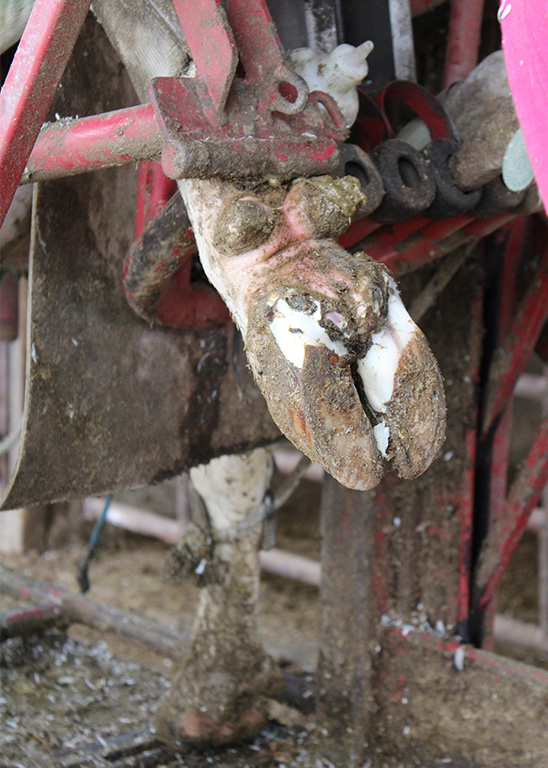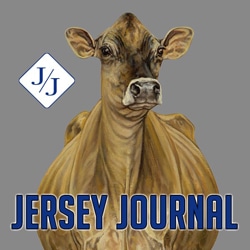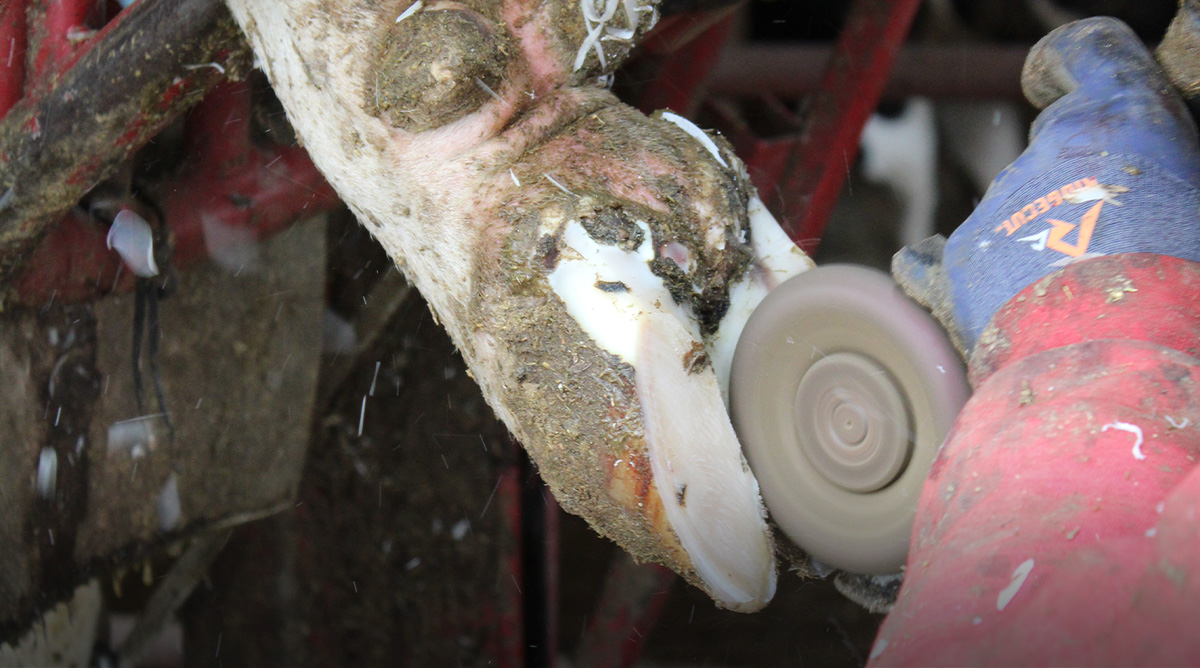Taking a Fresh Step
Hoof health affects the cow more than you think. If you aren’t trimming at least twice a year, per cow, you can lose up to $185 on a first lactation cow and $333 on a mature cow according to University of Kentucky Department of Animal and Food Sciences. Do you regularly trim your cows hooves? What is the importance of trimming, footing, prevention of diseases, and dealing with lameness? Two Ohio hoof trimmers explain the facts.
Allen Schlabach, Fredericksburg, Ohio, has been trimming hooves for 33 years. Looking back, it wasn’t his dream job. In fact he had two jobs off the farm in one year and then realized he missed the farm life. A fellow hoof trimmer wanted to sell his business and that is when Schlabach took the reins.
“I wanted to create a marketable business while providing excellent service to my customers,” noted Schlabach.
Tim Billman, West Salem, Ohio, has been trimming hooves for 23 years. In his mid-20s Billman started trimming as a result of his love for the industry, willingness to work with the animals, and appreciation of the dairy farmer. He trained with another hoof trimmer for a while and also took time to attend educational classes.
“One key learning practice is to talk to other trimmers and develop a connection with them,” Billman said.

Importance of Trimming
Do you want longevity and production from your cows? Then proper hoof trimming is a must. The importance of trimming is to keep the cow as mobile as possible.
“Just like an ill-fitting pair of shoes can cause blisters, sore feet in general make us less productive, same goes for the cows,” Schlabach explained. “Sore feet can cause a cow to lay down soon after milking before her teat end closes sufficiently, therefore higher probability of mastitis. She will spend less time at the feed bunk, less milk, showing poor estrus, longer calving intervals, etc. Her comfort should be a top priority because if she isn’t doing her job, you are losing money.”
When to Trim
When it comes to trimming, diseases, environment, bedding, stress, are some of the first things thought of. Various factors influence how the cows’ hooves grow. It is essential to keep cows trimmed twice a year to keep up with hoof health.
A helpful rotation to hoof trimming is trimming cows at dry off, then again at 100 days in milk, but when should farmers start to trim? Springing heifers is a great age to start trimming. The hoof wall grows at about two inches per year and the normal hoof should be three inches long from the coronary band to the toe. When weight is shifted while the hoof is growing, it could cause that female to go lame. As the cow matures, more weight is put on the outside walls of the rear feet. This is where they have more overgrowth. For hooves with overgrown toes, a heel with an altered structure will be more susceptible to bacterial invasion as it will be in contact with more manure.
“If trimming is just a band aid, there will be more problems in the near future,” said Schlabach.
When trimming is routine to keep claws in optimal health, the cow will be capable of performing to her potential. Waiting to trim after the onset of lameness is called corrective hoof trimming. Over-trimming can also be destructive to the structure of the hoof as the sensitive tissues could be penetrated below the wall, causing pain.
Common Hoof Diseases
The most common disease Billman has seen is the hairy heel wart. It is a virus that infects the skin and is typically located in the back of the foot, but can also be up front and in between the toes. Hairy warts are contagious and can spread through manure and frequently visited areas by those infected cows. This can cause the cow to lose mobility because of the soreness of the foot which can result in lameness if not treated and other issues regarding her health and milk production.
However, there are many other diseases to watch out for. Along with the hairy heel wart being a top contender, Schlabach said the top diseases that have the most dramatic effect on cows are ulcers and abscesses. Ulcers can form from standing too long. An example of this would be overcrowding, standing in headlocks too long, or in the holding pen. Abscesses are more prevalent when cows are slipping and sliding. Examples of this would be chasing cows to catch them, slippery surfaces, especially in winter time, or hot summertime temperatures can cause them to form.
With management and determination, these diseases could be prevented and taken care of at the source.
When talking about how nutrition is related to hoof health, laminitis is directly related to this topic. Laminitis is an aseptic inflammation of the dermal layers inside the foot that can come in acute, subclinical, and chronic cases. Rumen acidosis has been shown to be a key factor leading to laminitis. Acidosis is caused by the ingestion of greater than normal quantities of ruminally fermentable carbohydrates. Acidosis can cause hemorrhaging in the claw which predisposes her to an abscess.
Lameness
If hoof health is not a priority on the farm, there will be issues that arise for you and your cattle.
Lame cows don’t want to get up and move, therefore feed/water intake will decrease, resulting in lower milk production and reproductive issues.
There are numerous reasons cows can become lame such as an outbreak of hairy heel warts, hoof rot, erosion, change of feed, and stress. Factors include environmental changes. For example, is a cow standing longer to get more airflow on her body because she is hot?
“It is important for farmers to identify lame cows and take action with a hoof trimmer, vet, nutritionist, or confront the farm help,” said Billman.
“Interesting research from back in the 90s showed milk loss three weeks prior to any visible lameness,” Schlabach said. “How much profit is already lost when we identify lameness and treat the issue at hand? At that point, we are two to three months late.”
“Once they have lameness or an injury, there is scar tissue and there can be bone deformation which can make her susceptible to become a chronically lame cow,” continued Schlabach.
Evaluation
When trimmers such as Schlabach, look at a cow’s hoof before she gets trimmed, they are looking at length and angle of the toe, sole thickness balance, wear pattern on feet, and also if anything looks abnormal. They also evaluate pastern angle, sickle and straight hocks, and then determines how to best trim her hooves to get her comfortable again. While trimming, if any lesions are present in the claw, then they can dictate how the claw is trimmed. It is important to watch a cow “moove” and see how the trimmer can better assist her.
Footing
Footing is also a key factor to hoof health. Is the cow walking on concrete that is worn down, cracked, or broken; is she walking in sloppy manure a lot that could cause diseases to transfer easier? With a pack barn and total rubber flooring, cows need to be trimmed more often. Sand gives good traction, but if you have coarse/sharp sand you will probably be using a lot of blocks on thin soles. For ulcers or abscesses, placing a block on the good claw is very beneficial to remove weight bearing from the sore claw thus helping the healing process.
Prevention
“There is no unimportant job or part of a farm,” Schlabach said.
Environment and clean comfortable stalls so cows are able to get off of their feet and rest. Along with comfort, it is important to keep her trimmed regularly. A great preventative measure are footbaths. The best foot baths are proactive and only need minimal product to control hairy warts. Some farms need footbaths daily, while others need it only two or three times a week.
Formaldehyde, copper, and zinc are the most commonly used products in footbaths. To get something under control can take two to three years of consistency.
“Formaldehyde is the cheapest product, but it has some health risks that people need to be aware of while handling it,” explained Schlabach. “Three to five percent is common for a treatment bath, however, as low as one percent is effective to maintain control. Copper and zinc are heavy metals and need to be cautious about over-applying.”
“For the most part every product works, but making sure you get enough of the product on the cows hooves is the problem,” said Bilman.
These trimmers have seen terrible hoof cases. Unfortunately some farmers only trim cows when they need to and aren’t getting a regular trim. Schlabach said, “One cow I saw had avulsed both claw capsules on her left front foot from an unknown injury so she had to be euthanized.”
Billman said, “One of my worst farms only trims long toes and lame cows and performs, no maintenance trimming.” The farmer who puts it off, is pushing themselves back.
Future
“Hoof health = cow health = bottom line health,” said Schlabach. His best advice is to have a dedicated trimming area so there is no or minimal time required for setup and cow movement is easy. When having a plan, trimming day is not such a dreaded chore and will happen more frequently. This will enable more routine trimming instead of band aid fixes to keep cows healthy longer.
“Most of the trimmers out there have your best interest at heart,” said Billman. “The longer we can keep you in business, the happier we are.”




